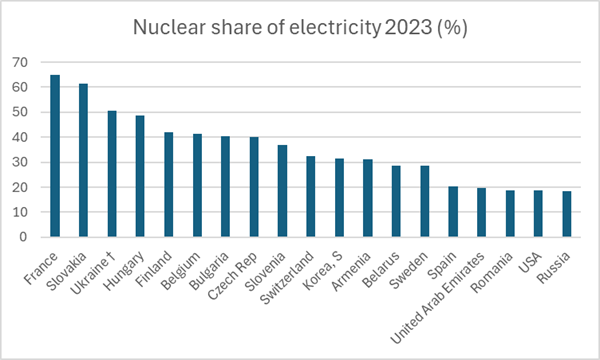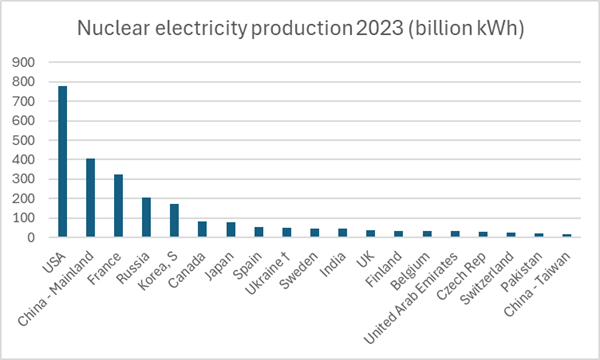Nuclear power would provide optionality across the energy spectrum in Australia. There is no valid argument for Australia to continue to ban the use of nuclear power. The removal of this ban would allow both the public and private sectors the ability to implement nuclear power generation if indeed, the investment decision, had validity. It would leave the Final Investment Decisions (FID) for nuclear power infrastructure to those financing and investment professional groups that have the necessary expertise to make that decision.
Safety concerns overblown
The overwhelming issue over the decades has been safety concerns regarding nuclear power. But when compared to other energy sources, nuclear safety is one of the least risky, according to the US Department of Energy. Over those decades, nuclear power has been utilised for power generation, in defence equipment such as nuclear submarines, and in nuclear medical infrastructure such as Lucas Heights in Sydney. There has been less than a handful of headline nuclear disaster. However, even these events have not resulted in fatalities as significant as compared to fossil fuel energy sources. And nuclear safety compares well to those of renewable energy sources.
Nuclear power is key for many countries
Nuclear power is an important low-emission source of electricity, providing about 10% of global electricity generation. In advanced countries, nuclear power generation rises to 20% of total energy source, per the International Energy Agency. Many countries rely on nuclear energy. Look no further than at the nuclear power plants that dot the France countryside, clearly observed during the television coverage of the Tour de France cycle race.
According to the International Atomic Energy Agency and the US Energy Information Agency, the countries with the largest total percentage of electrical generation being sourced from nuclear in 2023 were France (64.8%), Slovakia (61.3%), Hungary (48.8%), Finland (42%) and Belgium (41.2%). The US, China and France are the largest users of nuclear power generation in absolute terms. Approximately 20% of US and 5% of China electricity generation is from nuclear in 2023. There were approximately 440 power reactors and over 50 countries utilize nuclear energy in about 220 research reactors in 2023.


Source: World Nuclear Association. † Ukraine 2023 electricity generation estimated.
European nuclear power plants have been and are being revamped to meet the current power requirements. US tech companies are realising the ongoing and future demand of three large energy requirements – electrification, artificial intelligence and crypto mining – and entering long term power contracts with nuclear power utility companies for sustainable, reliable and continuous data centre power generation.
Partly due to this, the US Electric Power Research Institute estimates that by 2030, data centres will account for approximately 9% of overall US electricity consumption.
Additionally, US utilities are now increasingly including nuclear power sources in their future investment planning. Most of this investment planning is in nuclear energy through Small Modular Reactors (SMR). At the White House Summit on Domestic Nuclear Deployment In May 2024, Duke Energy, a US energy company, announced agreements with Amazon, Google, Microsoft and Nucor to explore new and innovative approaches to support carbon-free energy generation and help utilities serve the future energy needs of large businesses in North Carolina and South Carolina. Duke Energy is executing an ambitious clean energy transition, keeping reliability, affordability and accessibility at the forefront as the company works toward net-zero methane emissions from its natural gas business by 2030 and net-zero carbon emissions from electricity generation by 2050. The company is investing in major electric grid upgrades and cleaner generation, including expanded energy storage, renewables, natural gas and nuclear.
More are signing up to nuclear power
At COP28, the World Climate Action Summit of the 28th Conference of the Parties to the U.N, more than 20 countries from four continents launched the Declaration to Triple Nuclear Energy by 2050. The Declaration recognized the key role of nuclear energy in keeping within reach the goal of limiting temperature rise to 1.5 degrees Celsius. These countries included the US, France, Japan, UK, Sweden and Canada.
Importantly, at Climate Week events in New York in September 2024, and aligning with the commitment of these countries at COP28 to triple nuclear energy by 2050, a group of 14 major global financial institutions expressed support for expanding nuclear energy capacity. This is a commitment by the largest financial institutions that nuclear energy is fundamental to the energy decarbonisation transition requirement to zero carbon emissions by 2050. These financial institutions included Bank of America, Barclays, Citigroup, Goldman Sachs, Morgan Stanley and BNP Paribas.
The US Government has announced long term funding commitments to nuclear power facilities. The Inflation Reduction Act (IRA) provided substantial tax credits and increased the authorities of the Loan Programs Office (LPO) for the deployment of commercial technologies, while demonstration and research programs are funded and underway within the Office of Clean Energy Demonstrations (OCED) and the Office of Nuclear Energy (NE) to de-risk more innovative technologies.
Nuclear offers a differentiated power source in the energy transition to zero carbon emission. It will contribute to reducing the cost of decarbonisation by providing both necessary base load power and optionality, to overcome the disadvantages of renewable energy- namely, variable generation capacity, energy storage and transmission.
According to a recent US Government Department of Energy report, ‘Pathways to Commercial Liftoff: Advanced Nuclear’, the existing fleet of 94 nuclear reactors at 54 sites provide approximately 20% of US electricity generation and almost half of domestic carbon-free electricity. This report noted that ‘US nuclear capacity has the potential to triple from ~100 GW in 2024 to ~300 GW by 2050.’ Importantly this report identified that when total generation and transmission system costs are included, the overall energy power framework is estimated at 37% lower with nuclear as part of the energy mix compared to without nuclear.
At COP29 in November 2024, another six countries were added to the declaration to triple nuclear capacity by 2050. There are now 31 countries that have signed up to the declaration. Nuclear was discussed as a 24/7 energy solution including both electricity and heat and providing optionality and flexibility in decarbonizing global economies.
Australia is being left behind
In April 2024, the World Nuclear Association noted Australia has the largest known uranium resources representing almost one third of the global total uranium resources. It is the fourth largest uranium producer globally. This represents around 8% of global uranium. All Australian uranium is exported.
The overwhelming outcome from reviewing the current use of nuclear power globally is that Australia is an outlier amongst its Western allies when it comes to its energy policy. It’s an outlier to the country’s largest consumer of commodities – China. Is the Australian public going to rely on ideologically and politically based decision making to determine our energy future?
Stuart McKibbin is a consultant and independent contractor specialising in portfolio management, investment research, and industry and company thematic strategies. His five-decade long career includes oil and gas experience as a petroleum geologist, investment research and corporate finance. He has written and presented on macro investment themes, company analysis, managed accounts and ETFs.